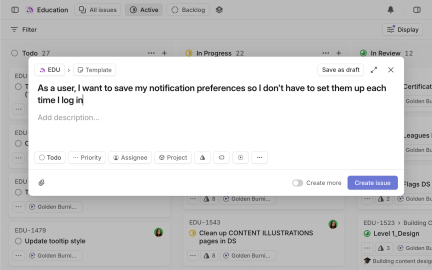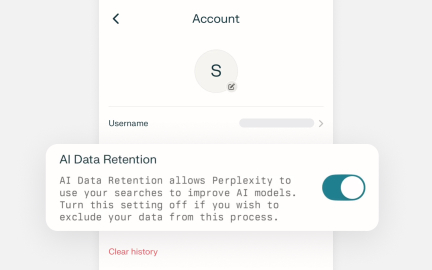Agile Principles
Agile principles support flexible, collaborative product development with a focus on user value, iterative delivery, and team autonomy.
What is Agile Principles?
Your development projects suffer from rigid planning and delayed feedback because traditional project management approaches don't adapt well to changing requirements and customer needs, leading to products that miss market opportunities and user expectations.
Most teams follow waterfall development approaches without systematic frameworks for adapting to change and incorporating user feedback, missing opportunities to create products that actually serve evolving customer needs and market conditions effectively.
Agile principles are a set of values and practices that prioritize customer collaboration, responding to change, working software, and individuals over rigid processes, enabling development teams to deliver value iteratively while adapting to changing requirements and user feedback.
Teams applying agile principles achieve 50% faster delivery cycles, 40% better customer satisfaction, and significantly improved adaptability because development processes embrace change rather than fighting against evolving requirements and market conditions.
Think about how successful software companies use agile development to release features quickly while incorporating user feedback, or how product teams use iterative development to validate assumptions and optimize products based on actual usage patterns.
Why Agile Principles Matter for Development Success
Your development processes create products that don't meet current user needs because planning assumes requirements won't change and customer feedback isn't incorporated until development is complete, leading to products that solve yesterday's problems rather than current market needs.
The cost of rigid development approaches compounds through every project that could adapt better to changing conditions. You get products that miss market timing, don't serve actual user needs, require extensive post-launch changes, and lose competitive advantage to more adaptive development approaches.
What effective agile principles application delivers:
Better customer value delivery and market responsiveness because agile development prioritizes working products that solve current customer problems rather than comprehensive features that might not serve evolving user needs and market conditions.
When development embraces agile principles, products evolve with customer needs rather than being locked into initial requirements that might not reflect current market reality and user priorities.
Enhanced team collaboration and communication effectiveness through agile practices that prioritize face-to-face communication and cross-functional teamwork rather than documentation and formal processes that might slow response to changing requirements.
Improved adaptability and change management because agile principles treat changing requirements as opportunities rather than problems, enabling teams to respond quickly to market feedback and competitive pressures.
Faster feedback cycles and learning optimization as frequent delivery enables rapid user feedback and course correction rather than waiting until project completion to discover whether products meet customer needs and market requirements.
Higher team motivation and ownership through agile practices that empower teams to make decisions and take responsibility for outcomes rather than just following predetermined plans without adaptation capability.
Advanced Agile Principles Capabilities
Scaled Agile Frameworks and Enterprise Implementation: Apply agile principles across large organizations and complex product portfolios rather than just individual team agile adoption without organizational coordination and strategic alignment.
DevOps Integration and Continuous Delivery Optimization: Combine agile development with operational excellence that enables rapid deployment and system reliability rather than just development agility without operational capability.
Customer-Centric Agile and Market Validation: Focus agile practices on customer value validation and market feedback rather than just development efficiency without strategic market positioning and competitive advantage consideration.
Agile Leadership and Cultural Transformation: Develop leadership capabilities and organizational culture that support agile principles rather than just process implementation without management support and cultural alignment.
Step 1: Understand Core Agile Values and Mindset (Week 1)
Learn the fundamental agile values of individuals over processes, working software over documentation, customer collaboration over contracts, and responding to change over following plans, rather than just implementing agile practices without philosophical understanding.
This creates agile foundation based on value system rather than just methodology adoption that might not reflect genuine commitment to adaptability and customer focus that drive agile success.
Step 2: Implement Iterative Development and Frequent Delivery (Week 1-2)
Break development work into short iterations that deliver working functionality regularly rather than long development cycles that delay customer feedback and market validation of product direction and user value.
Focus iterations on customer value delivery rather than just technical milestones that might not provide users with meaningful functionality and business stakeholders with progress visibility.
Step 3: Establish Customer Collaboration and Feedback Integration (Week 2)
Create systematic approaches for incorporating customer input throughout development rather than just gathering requirements at the beginning and hoping they remain relevant throughout extended development timelines.
Balance customer collaboration with development efficiency to ensure feedback improves products without creating constant interruption and scope changes that prevent completion of valuable functionality.
Step 4: Build Cross-Functional Teams and Collaborative Work Practices (Week 2-3)
Organize teams that include all skills needed for product delivery rather than siloed departments that require extensive coordination and formal handoffs that slow development and reduce adaptation capability.
Step 5: Embrace Change and Continuous Improvement (Week 3)
Develop organizational culture that views changing requirements as opportunities for better products rather than problems that disrupt predetermined plans and development schedules without strategic consideration.
This ensures agile principles generate sustainable competitive advantage rather than just development methodology adoption that doesn't improve customer value delivery and market responsiveness significantly.
If agile implementation doesn't improve development outcomes, examine whether teams embrace agile values rather than just following agile practices without philosophical commitment to adaptability and customer focus.
The Problem: Agile implementation that focuses on process adoption rather than value delivery and customer focus, creating agile theater that doesn't improve development outcomes and customer satisfaction meaningfully.
The Fix: Prioritize customer value and adaptability over process compliance, ensuring agile practices serve customer needs rather than just meeting agile methodology requirements without strategic impact.
The Problem: Agile practices that become rigid processes rather than adaptive approaches that respond to changing team needs and project contexts that require flexibility and continuous improvement.
The Fix: Adapt agile practices to team context and project requirements rather than rigid methodology application that might not serve specific development needs and organizational constraints effectively.
The Problem: Agile adoption that doesn't address organizational culture and leadership support needed for successful change management and sustained agile development effectiveness.
The Fix: Include leadership development and cultural change in agile transformation rather than just team process changes without organizational support and strategic alignment requirements.
Create agile principles application that enhances customer value delivery rather than just development methodology adoption that might not improve competitive positioning and market responsiveness significantly.
Recommended resources
Courses

Accessibility Foundations

Wireframing








